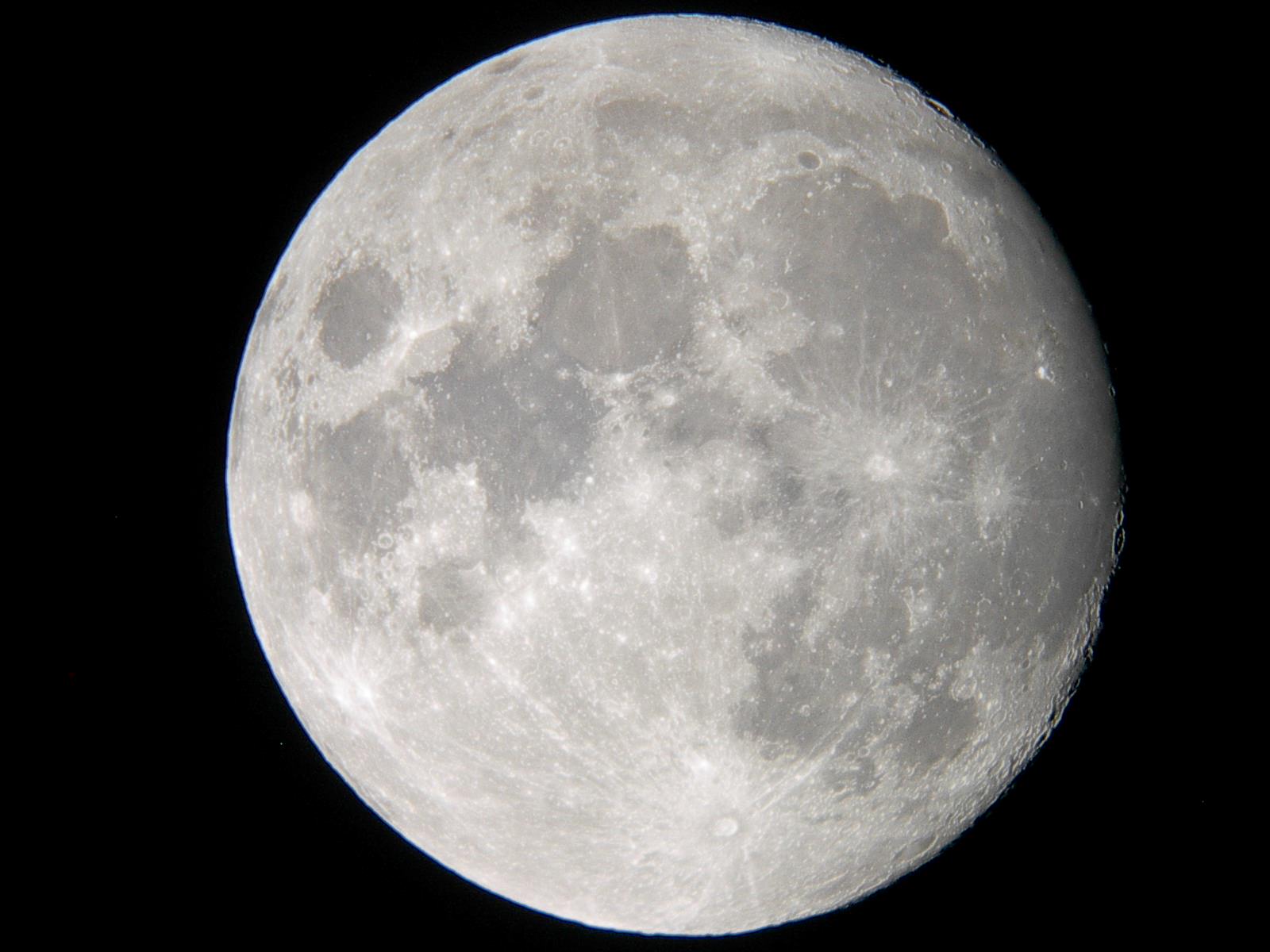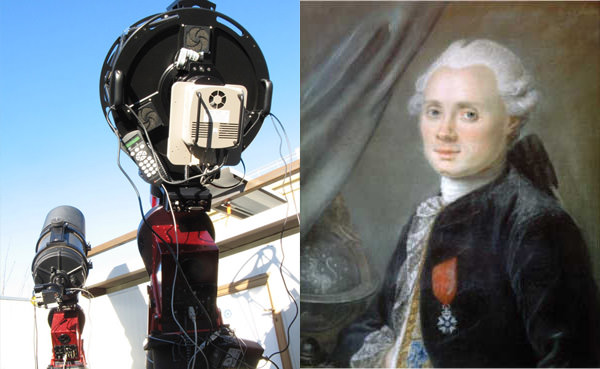Saturn is one of the most striking objects to see through a telescope, and it is now at its brightest in the night sky as it reaches opposition from the Sun. This is when Earth stands mostly perfectly in line between Saturn and the Sun. It is when Saturn is brightest (at magnitude +0.3), closely approximating famous “first magnitude” stars like Betelgeuse. Also, it is when Saturn is out all night long. Continue reading “Saturn Reaches Opposition on April 28”
A ‘Shallow’ Lunar Eclipse Coming on April 25
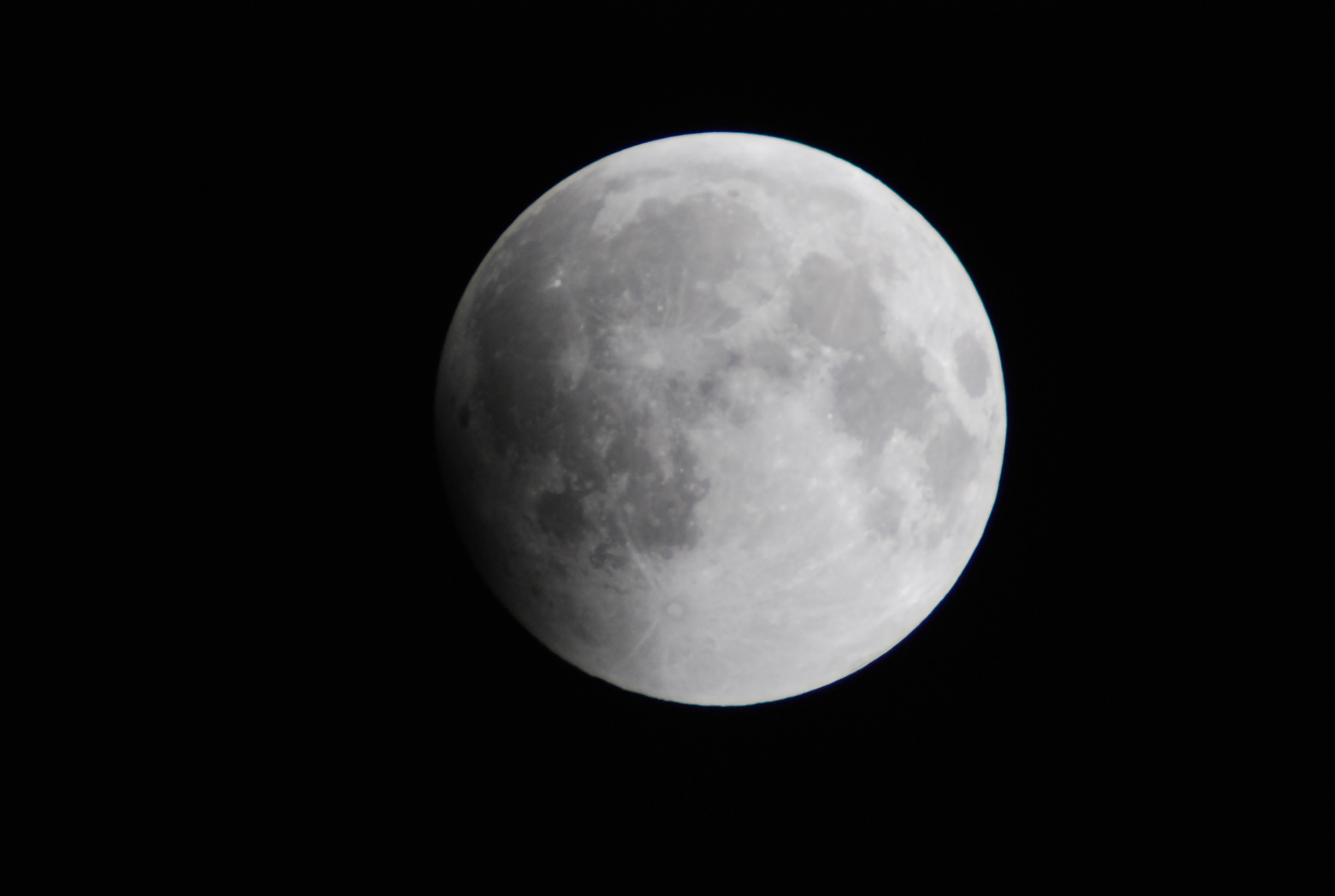
Eclipse season is upon us this week with the first eclipse of 2013, a brief partial lunar eclipse.
The lunar eclipse on April 25, 2013 is a shallow one, meaning only a paltry 1.47% of the lunar limb will be immersed in the dark umbra or inner shadow of the Earth. Observers can expect to see only a dark diffuse edge of the inner shadow nick the the Moon as is grazes the umbra.
A partial lunar eclipse this shallow hasn’t occurred since May 3rd, 1958 (0.9%) and won’t be topped until September 28th, 2034 (1.4%). This is the second slightest partial lunar eclipse for this century.
Another term for this sort of alignment is known as a syzygy, a great triple-letter word score in Scrabble!
A video simulation of the eclipse:
The eclipse will be visible in its entirety from eastern Europe & Africa across the Middle East eastward to southeast Asia and western Australia. The eclipse will be visible at moonrise from South America to Western Europe and occurring at moonset for eastern Australia and the Far East. The partially eclipsed Moon will be directly overhead just off the northeastern coast of Madagascar. The eclipse will not be visible from North America.
Two eclipse seasons occur each year when the nodal points of the Moon’s orbit intersect the ecliptic while aligned with the position of the Sun and the Earth’s shadow. The Moon’s orbit is inclined 5.15° degrees with respect to the ecliptic, which traces out our own planet’s path around the Sun. If this intersection occurs near New or Full Moon, a solar or lunar eclipse occurs.
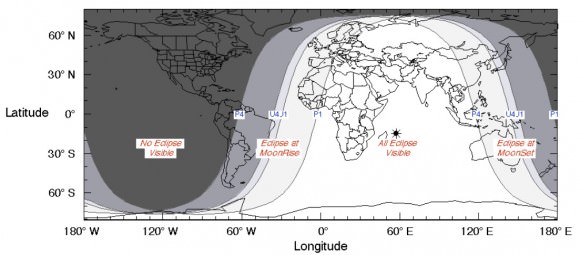
If the Moon’s orbit was not inclined to our own, we’d get two eclipses per lunation, one solar and one lunar.
2013 has 5 eclipses, 3 lunar and 2 annular. The minimum number of eclipses that can occur in a calendar year is 4, and the maximum is 7, as will next occur in 2038.
The 3 lunar eclipses in 2013 are this week’s partial eclipse on April 25th and two faint penumbral eclipses, one on May 25th and another on October 18th. There is no total lunar eclipse in 2013. The last one occurred on December 10th 2011, and the next one won’t occur until April 15th 2014, favoring the Pacific Rim region.
This eclipse will also set us up for the first solar eclipse of 2013, an annular eclipse crossing NE Australia (in fact crossing the path of last year’s total eclipse near Cairns) and the south Pacific on May 10th. The only solar totality that will touch the surface of the Earth in 2013 is the hybrid eclipse on November 3rd spanning Africa and the South Atlantic with a maximum totality of 1 minute & 40 seconds.
Contact times for the April 25 shallow eclipse:
P1-The Moon touches the penumbra-18:03:41 UT
U1-The Moon touches the umbra-19:54:04 UT
Mid-Eclipse-20:08:37.5 UT
U4 -The Moon quits the umbra-20:21:04 UT
P4-The Moon quits the penumbra- 22:11:23 UT
The length of the partial phase of the eclipse is exactly 27 minutes, and the length of the entire eclipse is 4 hours, 7 minutes and 42 seconds.
This particular eclipse is part of saros series 112 and is member 65 of 72.
This saros cycle began in 859 C.E. on May 20th and will end in 2139 on July 12th with a penumbral lunar eclipse. One famous member of this series was 52. This eclipse was one of many used by Captain James Cook to fix his longitude at sea on December 4th 1778. Christopher Columbus also attempted this feat while voyaging to the New World. It’s a fun project that anyone can try!
I also remember watching the last eclipse in this series from South Korea on April 15th 1995, a slightly better partial of 11.14%.
An occultation of the bright star Spica occurs just 20 hours prior as seen from South Africa across the southern Atlantic. This the 5th in a series of 13 occultations of the star by the Moon in 2013.
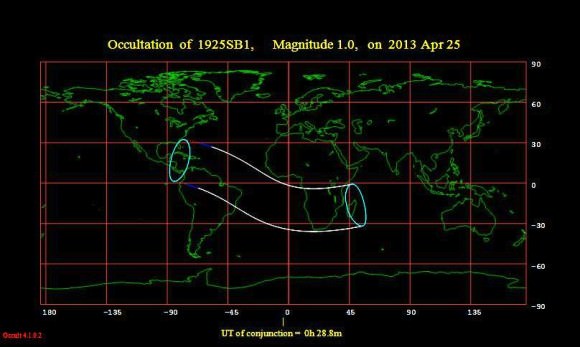
The +2.8th magnitude star Zubenelgenubi (Alpha Librae) is occulted by the waning gibbous Moon just 15 hours after the eclipse for Australia and the South Pacific.
Another occultation of a bright star with potential this week is +4.7th magnitude Chi Virginis across North America on the morning of Wednesday, April 24th centered on 4:24 UT.
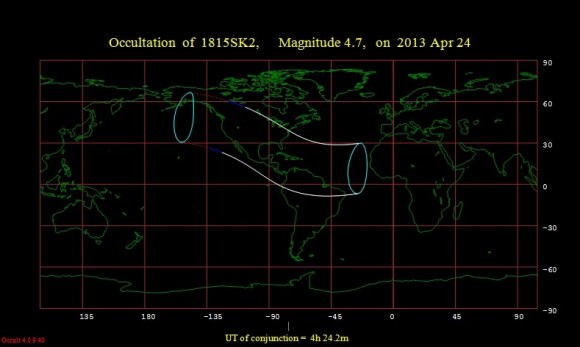
Also keep an eye out for +0.1 magnitude Saturn near the Full Moon. Saturn reaches opposition this weekend for 2013 on April 28th
Full Moon occurs near mid-eclipse at 20:00 UT/16:00 EDT on April 25th. Colloquial names for the April Full Moon are the Pink, Fish, Sprouting Grass, Egg, Seed, & Waking Moon.
Sure, the penumbral phases of an eclipse are subtle and may not be noticeable to the naked eye… but it is possible to see the difference photographically. Simply take a photo of the Moon before it enters the Earth’s penumbra, then take one during the penumbral phase and then another one after. Be sure to keep the ISO/f-stop and shutter speed exactly the same throughout. Also, this project only works if the eclipsed Moon is high in the sky throughout the exposures, as the thick air low to the horizon will discolor the Moon as well. Compare the shots; do you see a difference?
A penumbral eclipse would offer a good proof of concept test for hunting for transiting exoplanets as well, although to our knowledge, no one has ever attempted this.
Finally, calling out to all Universe Today readers in Madagascar. YOU may just be able to catch a transit of the International Space Station in front of the Moon just as the ragged edge of the umbra becomes apparent on the limb of the Moon. Check CALSky a day or so prior to the eclipse for a refined path… it would be an unforgettable pic!
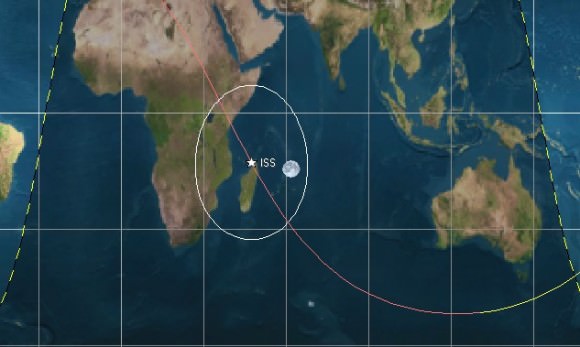
And if any ambitious observer is planning to live stream the eclipse, let us know and we’ll add your embed to this post. We do not expect an avalanche of web broadcasts, but hey, we’d definitely honor the effort! Slooh is usually a pretty dependable site for live eclipse broadcasts, and as of this writing seems to have broadcast scheduled in the cue.
Happy eclipse-spotting!
The Curious History of the Lyrid Meteor Shower
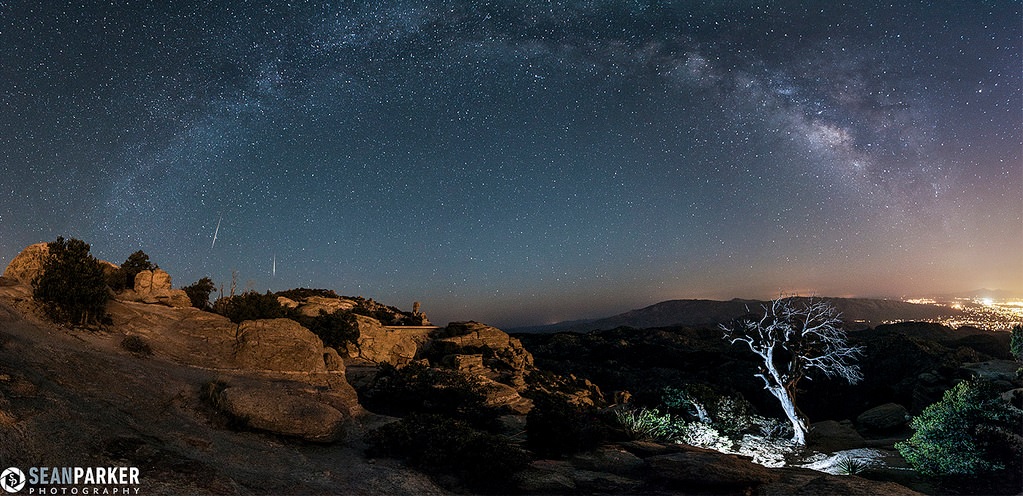
Today we residents of planet Earth meet up with a meteor stream with a strange and bizarre past.
The Lyrid meteors occur annually right around April 21st to the 23rd. A moderate meteor shower, observers in the northern hemisphere can expect to see about 20 meteors in the early morning hours under optimal conditions. Such has been the case for recent years past, and this year’s presence of a waxing gibbous Moon has lowered prospects for this April shower considerably in 2013.
But this has not always been the case with this meteor stream. In fact, we have records of the Lyrids stretching back over the past 2,600 years, farther back than any other meteor shower documented.
The earliest account of this shower comes from a record made by Chinese astronomers in 687 BC, stating that “at midnight, stars dropped down like rain.” Keep in mind that this now famous assertion that is generally attributed to the Lyrids was made by mathematician Johann Gottfried Galle in 1867. It was Galle along with Edmond Weiss who noticed the link between the Lyrids and Comet C/1861 G1 Thatcher discovered six years earlier.
Comet Thatcher was discovered on April 5th, 15 days before it reached perihelion about a third of an astronomical unit (A.U.) from the Earth. Comet Thatcher a periodic comet on a 415 year long orbital period.
But in the early to mid-19th century, the very idea that meteor showers were linked to comets or even non-atmospheric phenomena was still hotly contested.
One singular event more than any other triggered this realization. The Leonid meteor storm of 1833 in the early morning hours of November 13th was a stunning and terrifying spectacle for residents of the U.S eastern seaboard. This shower produces mighty outbursts, often topping a Zenithal Hourly Rate (ZHR) of over a 1,000 once every 33 to 34 years. I witnessed a fine outburst of the Leonids from Kuwait in 1998, and we may be in for a repeat performance from this shower around 2032 or 2033.
There is substantial evidence that the Lyrids may also do the same at an undetermined interval. On April 20th 1803, one of the most famous accounts of a “Lyrid meteor storm” was observed up and down the United States east coast. For example, one letter to the Virginia Gazette states;
“From one until three, those starry meteors seemed to fall from every point in the sky heavens, in such numbers as to resemble a shower of sky rockets.”
Another account published in the Raleigh, North Carolina Register states that:
“The whole hemisphere as far as the extension of the horizon seemed illuminated; the meteors kept no particular direction but appeared to move in every way.”
A study of the 1803 Lyrid outburst by W.J. Fisher cites over a dozen accounts of the event and is a fascinating read. Viewers were also primed for the event by the dramatic Leonid storm of 1799 four years earlier.
Interestingly, the Moon was only one day from New phase on the night of the 1803 Lyrids. Prime meteor watching conditions.
An unrelated meteorite fall would also occur four years later over Weston, Connecticut on December 14th, 1807 as recounted by Kathryn Prince in A Professor, A President, and a Meteor. These events would place Yankee politics at odds with the origin of meteors and rocks from the sky.
An apocryphal quote is often attributed to President Thomas Jefferson that highlights the controversy of the day, saying that “I would more easily believe that two Yankee professors would lie than that stones would fall from heaven.”
While both are of cosmogenous origin, no meteorite fall has ever been linked to a meteor shower, which is spawned by dust debris from comets. For example, many in the media erroneously speculated that the Sutter’s Mill meteorite that fell to Earth on the morning of April 22nd, 2012 was in fact a Lyrid meteor.
But a Lyrid may be implicated in another unusual 19th century observation. On April 24th 1874, a professor Scharfarik of Prague, Czechoslovakia was observing the daytime First Quarter Moon with his 4” refractor. The good professor was surprised by an “Apparition on the disc of the Moon of a dazzling white star,” which was “quite sharp and without a perceptible diameter.” Possible suspects are a telescopic meteor moving towards or along the observers’ line of sight or perhaps a Lyrid impacting the dark limb of the Moon.
Moving into the 20th century, rates for the Lyrids have stayed in the ZHR=20 range, with notable peaks of 100+ per hour noted by Japanese observers in 1922 and 100 per hour noted by U.S. observers in 1982.
It should also be noted that another less understood shower radiates from the constellation Lyra in mid-June. First noted Stan Dvorak while hiking in the San Bernardino Mountains in 1966, the June Lyrids produce about 8-10 meteors per hour from June 10 to the 21st. The source of this newly discovered shower is thought to be Comet C/1915 C1 Mellish.
A June Lyrid may have even made its way into modern fiction. As recounted in a July 2004 issue of Sky & Telescope, researchers Marilynn & Donald Olson note the following line from James Joyce’s Ulysses:
“A star, precipitated with great apparent velocity across the firmament from Vega in the Lyre above the zenith.”
Joyce seems to be describing a June Lyrid decades before the shower was officially recognized. The constellation Lyra rides high in the early morning sky for mid-northern latitudes in the early summer months.
All interesting concepts to ponder as we keep an early morning vigil for the Lyrids this week. Could there be more Lyrid storms in the far off future, as Comet Thatcher reaches perihelion once again in the late 23rd century? Could more historical clues of the untold history of this and other showers be awaiting discovery?
Somewhat closer to us in time and space, Paul Wiegert of the University of Ontario has also recently speculated that Comet 2012 S1 ISON may provoke a meteor shower on January 12th, 2014. Regardless of whether ISON turns out to be the “Comet of the Century,” this could be one to watch out for!
A New Look at the Horsehead Nebula for Hubble’s 23rd Anniversary
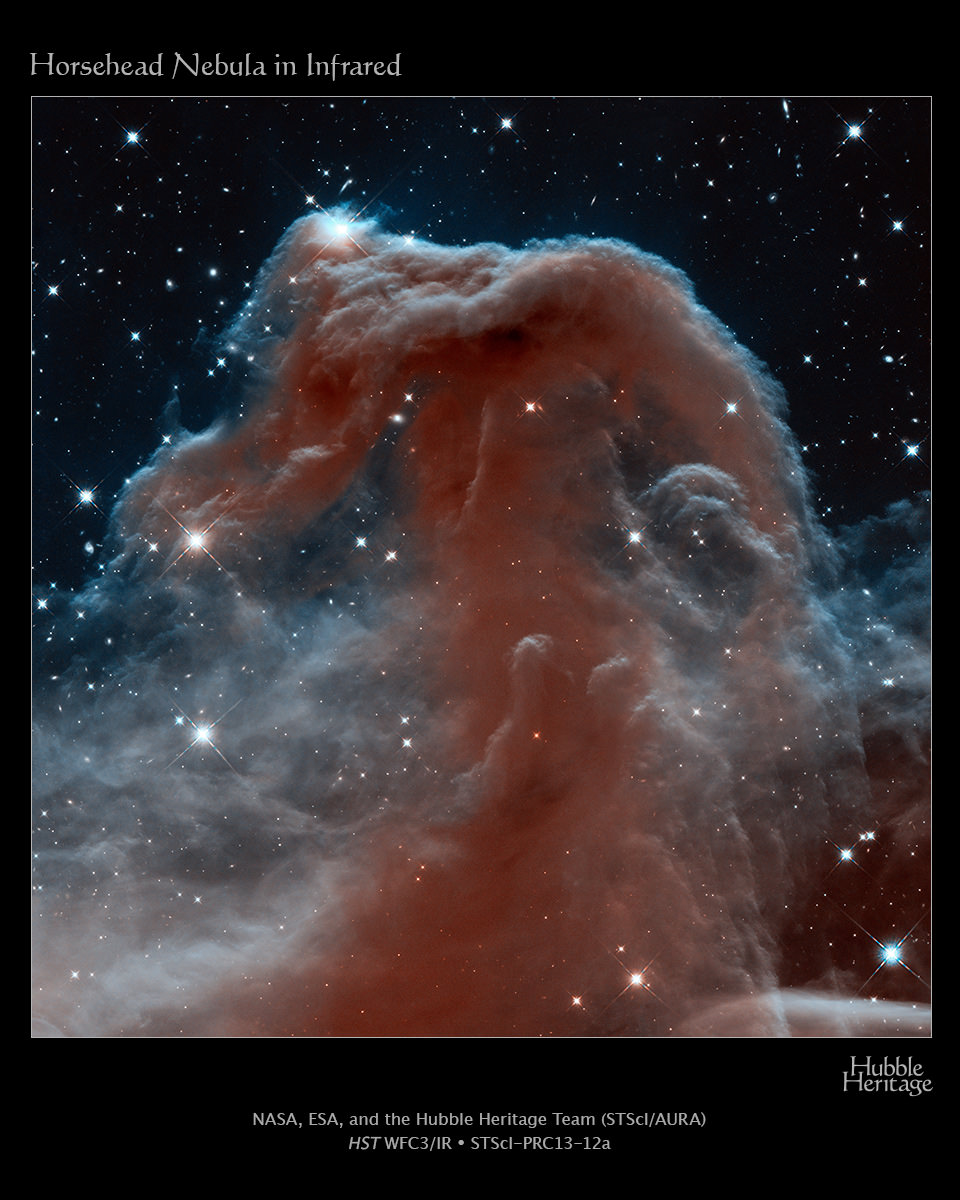
Here’s the iconic Horsehead Nebula as we’ve not seen it before. As the Hubble team so poetically puts it, the nebula looks “like an apparition rising from whitecaps of interstellar foam.” The new image of the Horsehead was photographed in celebration of the 23rd anniversary of the launch of Hubble aboard the space shuttle Discovery, on April 24, 1990.
Can you believe the Hubble Space Telescope has been in space for 23 years? … and it’s been churning out great images for almost 20 years since it was fixed in space during the first Hubble servicing mission in 1993.
This view shows the nebula in infrared wavelengths. When seen in optical light (see below), it appears dark and shadowy, but is “transparent and ethereal when seen in the infrared, represented here with visible shades. The rich tapestry of the Horsehead Nebula pops out against the backdrop of Milky Way stars and distant galaxies that are easily seen in infrared light,” the Hubble team said.
Gas clouds surrounding the Horsehead have already dissipated, but the tip of the jutting pillar contains a slightly higher density of hydrogen and helium, laced with dust. This casts a shadow that protects material behind it from being photo-evaporated, and a pillar structure forms. Astronomers estimate that the Horsehead formation has about five million years left before it too disintegrates.
The Horsehead Nebula is part of a much larger complex in the constellation Orion. Known collectively as the Orion Molecular Cloud, it also houses other famous objects such as the Great Orion Nebula (M42), the Flame Nebula, and Barnard’s Loop. At about 1,500 light-years away, this complex is one of the nearest and most easily photographed regions in which massive stars are being formed.
Hubble’s pairing of infrared sensitivity and unparalleled resolution offers a tantalizing hint of what the upcoming James Webb Space Telescope, set for launch in 2018, will be able to do.
Here’s a view in optical from Hubble:
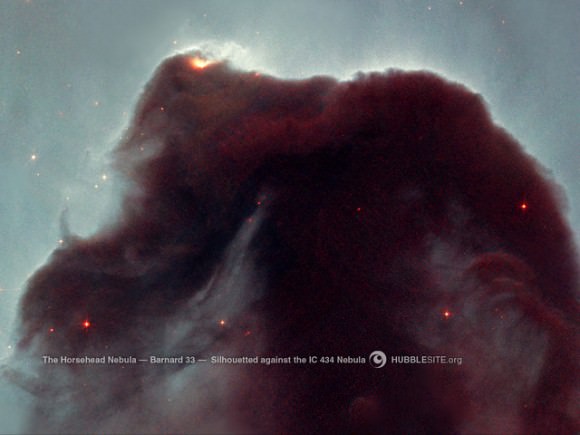
Image Credit: NASA, NOAO, ESA and The Hubble Heritage Team (STScI/AURA)
For more details, see the HubbleSite
Astrophoto: Space Station Flies Through the Moon!
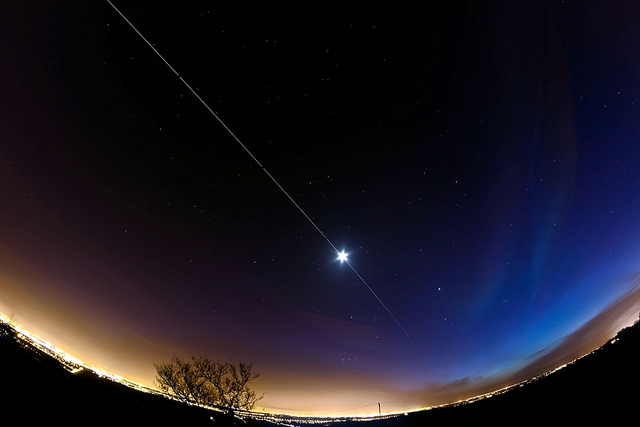
What a great image! Astrophotographer Dave Walker combined seven 30-second shots of the ISS as it cuts through the sky, and it appears to slice right through the Moon! Dave used a a Canon 600D, Samyang 8mm fish-eye lens, and Vixen Polarie.
Now through the end of April provides some great sighting opportunities in the northern hemisphere for seeing the International Space Station as it flies overhead — and over your backyard! Some evenings there are even two passes. See below for another great panorama of an ISS pass, as well as information on how to find out when you can see it. It’s always an amazing sight!
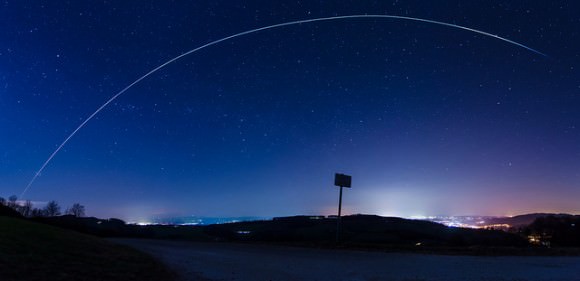
NASA has a Skywatch page where you can find your specific city to look for satellite sighting info.
Spaceweather.com, has a Satellite Tracker Tool. Just put in your zip code (good for the US and Canada) to find out what satellites will be flying over your house.
Heaven’s Above also has a city search, but also you can input your exact latitude and longitude for exact sighting information, helpful if you live out in the country.
Want to get your astrophoto featured on Universe Today? Join our Flickr group or send us your images by email (this means you’re giving us permission to post them). Please explain what’s in the picture, when you took it, the equipment you used, etc.
How to Spot the Antares Launch from NASA Wallops on Wednesday

A space launch marking a new era is departing from the Virginia coast this Wednesday evening, and if you live anywhere along a wide area of the US Eastern seaboard, you’ll have a great opportunity to witness the launch with your own eyes. Here’s all the information you’ll need to see it, plus some tips for capturing it with your camera.
Orbital Sciences’ Antares rocket will launch from Pad 0A at NASA’s Mid-Atlantic Regional Spaceport based on Wallops Island, Virginia. This will mark not only the first launch of Antares, but the first orbital launch of a liquid-fueled rocket from Wallops. The launch window runs from 5:00 to 8:00 PM EDT (21:00-24:00 UT).
There were some concerns when a technical anomaly shutdown a “Wet Dress Rehearsal” test this weekend at T-16 minutes, but Orbital Sciences has stated that the problems have been resolved and the launch is pressing ahead as planned.
Space shots are a familiar sight to the residents of the Florida Space Coast, but will provide a unique show for residents of the U.S. central Atlantic region. The launch of Antares from Wallops will be visible for hundreds of miles and be over 10° above the horizon for an arc spanning from Wilmington, North Carolina to Washington D.C. and north to the New York City tri-state area as it heads off to the southeast. Antares is a two stage rocket with a 1st stage liquid fueled engine and a solid-fueled 2nd stage. The primary mission for Wednesday’s Antares A-One flight will be to demonstrate the ability for the Antares rocket to place a payload into orbit. If all goes well, Orbital Sciences will join SpaceX this summer in the select club of private companies with the ability provide cargo delivery access to the International Space Station in Low Earth Orbit.
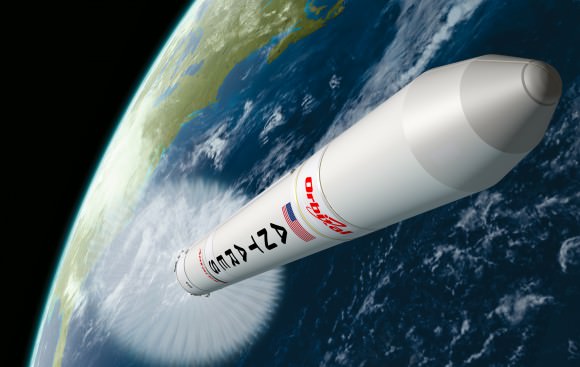
Antares will deploy a dummy mass simulating the Cygnus module. Also onboard are the Phonesat-1a, -1b, and -1c micro-cubesats and the Dove 1 satellite.
Be sure to watch for the launch of Antares if you live in the region. Find a spot with a low uncluttered eastern horizon and watch from an elevated rooftop or hilltop location if possible. I live a hundred miles west of Cape Canaveral and I’ve followed launches all the way through Main Engine Cutoff and first stage separation with binoculars.
Be sure to also follow the launch broadcast live for any last minute delays via NASA TV or Universe Today will have a live feed as well. Antares is aiming to put the Cygnus test mass in a 250 x 300 kilometre orbit with a 51.6° inclination. This is similar to what will be necessary to head to the ISS, but this week’s launch will not be trailing the ISS in its path. This also means that the launch window can be extended over three hours rather than having to be instantaneous.
If the launch goes at the beginning of the window, the local sun angle over the launch facility will be 30° to the west. Sunset at Wallops on the evening of April 17th occurs at 7:41PM EDT, meaning we could be in for a photogenic dusk launch of Antares if it stretches to the end of the target window.
And speaking of which, a pre-sunset launch means short daytime exposure settings for photography. Be prepared to switch over for dusk conditions if the launch extends into the end of the window. Conditions during twilight can change almost moment-to-moment. One of the most memorable launches we witnessed was the pre-dawn liftoff of STS-131 on April 5th, 2010:
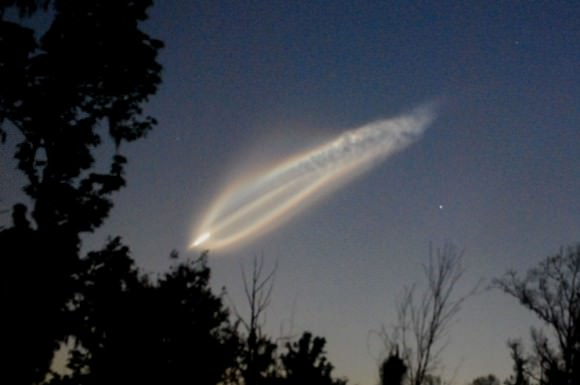
Once in orbit, the launch of Antares should generate four visible objects; the test mass payload, the two clam-shell fairings, and the stage two booster. This configuration is similar to a Falcon 9/Dragon launch, minus the solar panel covers. These objects should be visible to the naked eye at magnitudes +3 to +5. The cubesat payloads are tiny and below the threshold of naked eye visibility.
Preliminary visibility for the objects will favor latitudes 0-30° north at dusk to 10-40° at dawn. Keep in mind these predictions could change as the launch window evolves. The next NORAD tracking ID in the queue is 2013-015A. Yesterday’s launch of Anik G1 from Baikonur was just cataloged today as 2013-014A plus associated hardware. The weather is forecast to be 45% “go” for tomorrow’s launch. In the event of a scrub, the next launch window for Antares is April 18-21st.
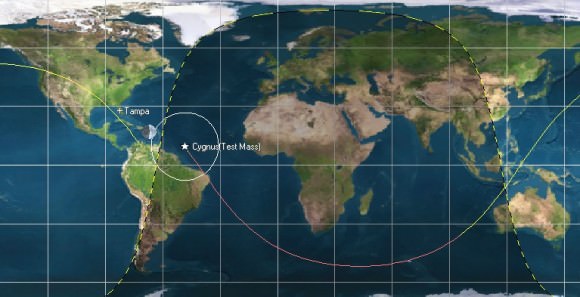
It’ll be exciting to follow this first flight of Antares and its first scheduled mission to the International Space Station this summer. Also watch for the first ever lunar mission to depart Wallops on August 12 with the launch of the Lunar Atmosphere and Dust Environment Explorer (LADEE).
Finally, if you’ve got a pass of the International Space Station this week, keep an eye out for Progress M-17M currently about 10 minutes ahead of the station in its orbit. The unmanned Progress vehicle just undocked yesterday from the station and will be conducting a series of experiments monitoring the interactions of its thrusters with the ionosphere before burning up on reentry over the South Pacific on April 21st.
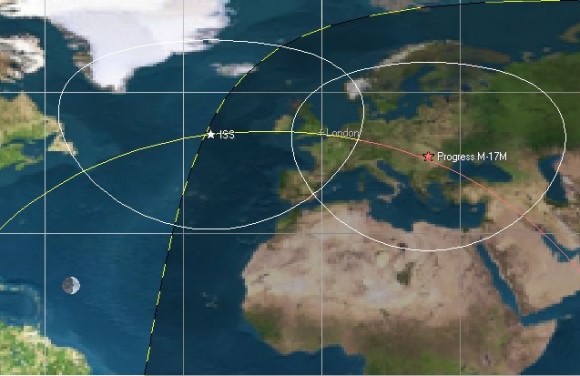
The ISS and more can be tracked using Heavens-Above. Also, we’ll be tweeting all of the updates and orbital action as it evolves as @Astroguyz. Let us know of those launch sightings both near and far. It’ll be interesting to see what, if any, impact launches visible to a large portion of the U.S. population will have on the public’s perception of spaceflight. Be sure to look up tomorrow night!
Mysterious Moon Flashes: Could the Transient Lunar Phenomena be Linked to the Solar Cycle?
A key mystery in observational lunar astronomy may be at least partially resolved.
An interesting study appeared recently in the British Astronomical Association’s (BAA) March 2013 edition of their Lunar Section Circular. The study is one of the most comprehensive looks at possible connections between Transient Lunar Phenomena and the Solar Cycle.
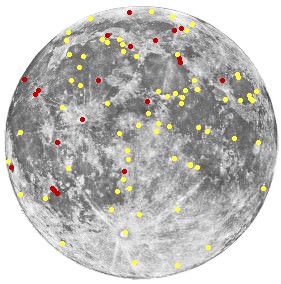
Transient Lunar Phenomena (or TLPs) are observations collected over the years of flashes or glows on the Moon. Since these phenomena often rely on a report made by a solitary observer, they have been very sparsely studied.
The term itself was coined by Sir Patrick Moore in 1968. One of the very earliest reports of a TLP event was the flash seen on the dark limb of the waxing crescent Moon by Canterbury monks in 1178.
Other reports, such as a daylight “star near of the daytime crescent Moon” seen by the residents of Saint-Denis, France on January 13, 1589 was almost certainly a close conjunction of the planet Venus. Bright planets such as Venus can be easily seen next to the Moon in the daytime.
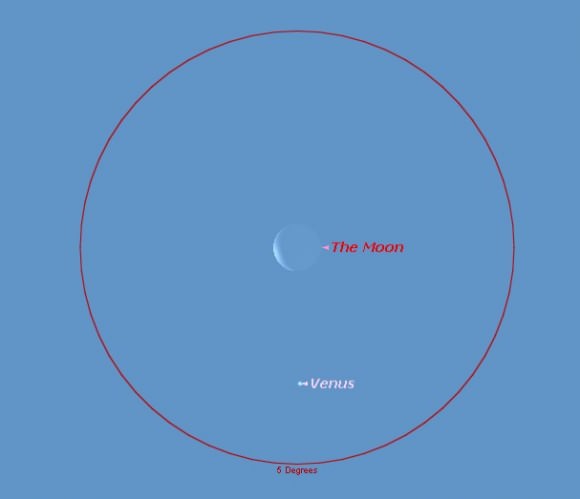
A stunning illusion also occurs when the Moon occults, or passes in front of a bright star or planet. In fact, there’s a name for this psychological phenomenon of a bright star seeming to “hang” between the horns of the Moon just prior to an occultation, known as the Coleridge Effect. This takes its name from a line in Coleridge’s Rime of the Ancient Mariner;
“Till clomb above the eastern bar, the horned Moon with one bright star,
Within nether tip.”
Okay, we’ve never seen the “horned Moon clomb,” either. But this does describe a real illusion often seen during an occultation. The mind thinks that gap between the horns of the Moon should be transparent, and the lingering planet or star seems to cross that space on the dark limb, if only for a second. Incidentally, South American residents will get to check this out during the next occultation of Venus this year on September 8th.
So, what does this have to do with the 11-year solar cycle? Well, when you strip away many of the dubious observations of TLPs over the years, a core of well- documented events described by seasoned observers remains. Anyone who has sketched such a complex object as the Moon realizes that fine detail becomes apparent on scrutiny that may be missed in a casual glance. But one persistent assertion that has gone around the astronomical community for years is that an increase in the number of TLP events is linked to the peak of the solar cycle.
This was first suggested in 1945 by H. Percy Wilkins. A later study by Barbara Middlehurst in 1966 disproved the idea, citing no statistical correlation between sunspot activity and TLPs.
Of course, pundits have tried unsuccessfully to link the solar cycle to just about everything, from earthquakes to human activity to booms and busts of the stock market. Most flashes on the dark limb of the Moon are suspected to be meteorite impacts. In fact, the advent of high-speed photography has been able to reveal evidence for lunar strikes during intense meteor showers such as the Leonids and Geminids.
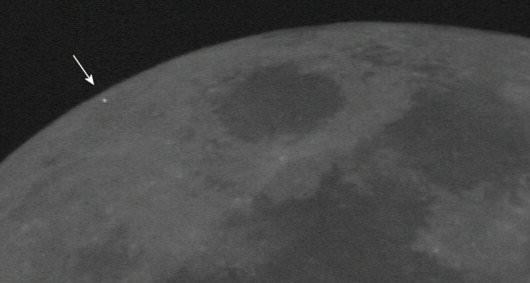
What’s at little less clear are the source of luminous “hazes” or “glows” noted by observers. Keep in mind; we’re talking subtle effects noted after meticulous study. NASA even commissioned a study of TLPs named Project Moon-Blink during the early Apollo program. About a third of TLP events have been observed near the bright crater Aristarchus. Researchers even managed to get Neil Armstrong to make an observation of the crater during a pass on Apollo 11. He noted that “there’s an area that is considerably more illuminated than the surrounding area. It seems to have a slight amount of fluorescence.”
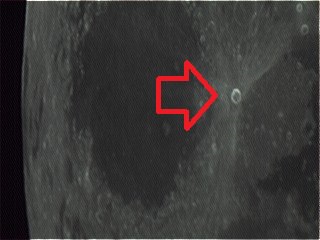
But what’s interesting in the recent BAA study conducted by Jill Scambler is the amount of data that was available. The study was a comprehensive analysis of TLPs noted by the BAA, the Association of Lunar and Planetary Observers (ALPO) and NASA from 1700 to 2010. Observations were weighted from 1 to 5, with 1 for reports from inexperienced observers to 5 for definitive and unambiguous TLP events.
The periodogram analysis comparing the frequency of TLPs with the sunspot cycle utilized a tool available from NASA’s Exoplanet Database to evaluate the data. If there was any mechanism whereby TLPs were being generated by solar activity, it had been suggested previously by Wilkins that perhaps out-gassing was being caused be solar irradiation or lunar dust was becoming electrostatically charged and suspended.
In fact, Surveyor 7 witnessed such a phenomenon during lunar twilight. To date, no human has witnessed a sunrise or sunset from the surface of the Moon, although astronauts witnessed several from lunar orbit.
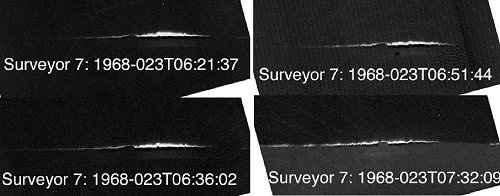
The final conclusion of the BAA study cites that “Although there are theories that might infer that TLP would be more frequent during solar activity, from a sunspot cycle perspective there is no evidence to support this.”
The report provides an interesting perspective on the topic, especially with solar cycle 24 peaking over the next year. It also seems that reports of TLPs have declined in past decades. One of the most famous examples was the flash imaged on the Moon (thought to be a Leonid) by Leon Stuart in 1953. But in the modern era of astrophotography with the Moon under nearly continuous scrutiny, where are all the images of TLPs?
Granted, a core number (2%) of events suggest evidence of real activity on a Moon that we most often think of as geologically dead. As for the spurious sightings, it helps to recall the number of “sightings” in the 19th century of Vulcan transiting the face of the Sun. Where is Vulcan today, with the Sun being monitored around the clock?
We’re not immune to this sort of “echo effect” in the modern world of astronomy, either. For example, whenever an impact scar or flash is noted on Jupiter, as occurred in 2009 and 2012, other sightings are “seen” throughout the solar system. A similar psychological phenomenon occurred when Comet Holmes brightened in 2007. For a time, reports flying around the Internet suggested many comets where suddenly increasing in brightness!
It also interesting to note that many features such as Aristarchus and Ina Caldera also have a high brightness or albedo. Although the Full Moon seems pearly white, the albedo of the Moon is actually quite low at (13%), about that of worn asphalt. Bright ejecta and rays tend to stand out, especially approaching a Full Moon, such as occurs on May 25th.
You can even enhance the saturation of those lunar pics to bring out subtle color and reveal that the Moon isn’t as monochromatic as it appears to the naked eye;
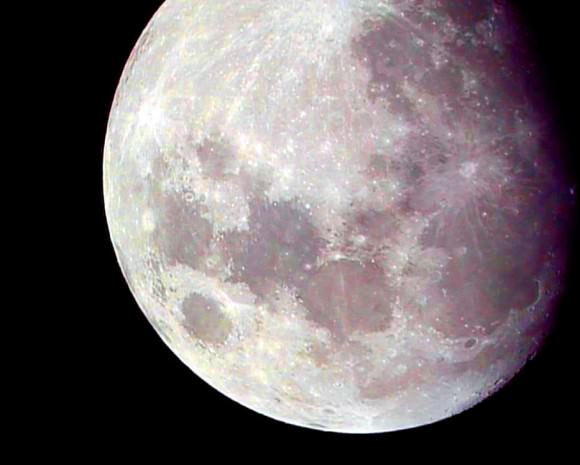
Kudos to the team at the BAA for casting a critical scientific eye on a little studied phenomenon. Perhaps missions such as the Lunar Atmosphere and Dust Environment Explorer (LADEE) departing for the Moon this summer will shed more light on the curious nature of Transient Lunar Phenomena.
-The study can be read in the March 2013 edition of the British Astronomical Association’s Lunar Section Circular available as a free pdf.
Join in an Online Messier Marathon
Have you ever done a Messier Marathon? Want to try it online from the comfort of your own home? Astrophysicist Gianluca Masi will host a webcast today (April 9, 2013) at 18:00 UTC (2 pm EDT) (update: this webcast has been postponed due to clouds. We’ll post the new date and time when it becomes available). You can join in at this link, and explore the many treasures of the famous Messier Catalog. Masi said they will try to see as many of 110 objects in the Messier Catalog as possible in a single viewing session. This is what is called a Messier Marathon!
This is the fifth time the Virutal Telescope Project has attempted this, and they’ve had great success previously. Masi is doing the Marathon their robotic telescopes, and will provide real time images and live comments, along with answering your questions and “sharing your passion and excitement with friends from all around the world.”
For more information on how to join in see the Virtual Telescope Project’s website. For more info on a Messier Marathon and how to do one, see our excellent recent post by David Dickinson.
Here’s some examples of what you will be seeing today during the webcast:
A Detailed Look at the Coma of Comet PANSTARRS
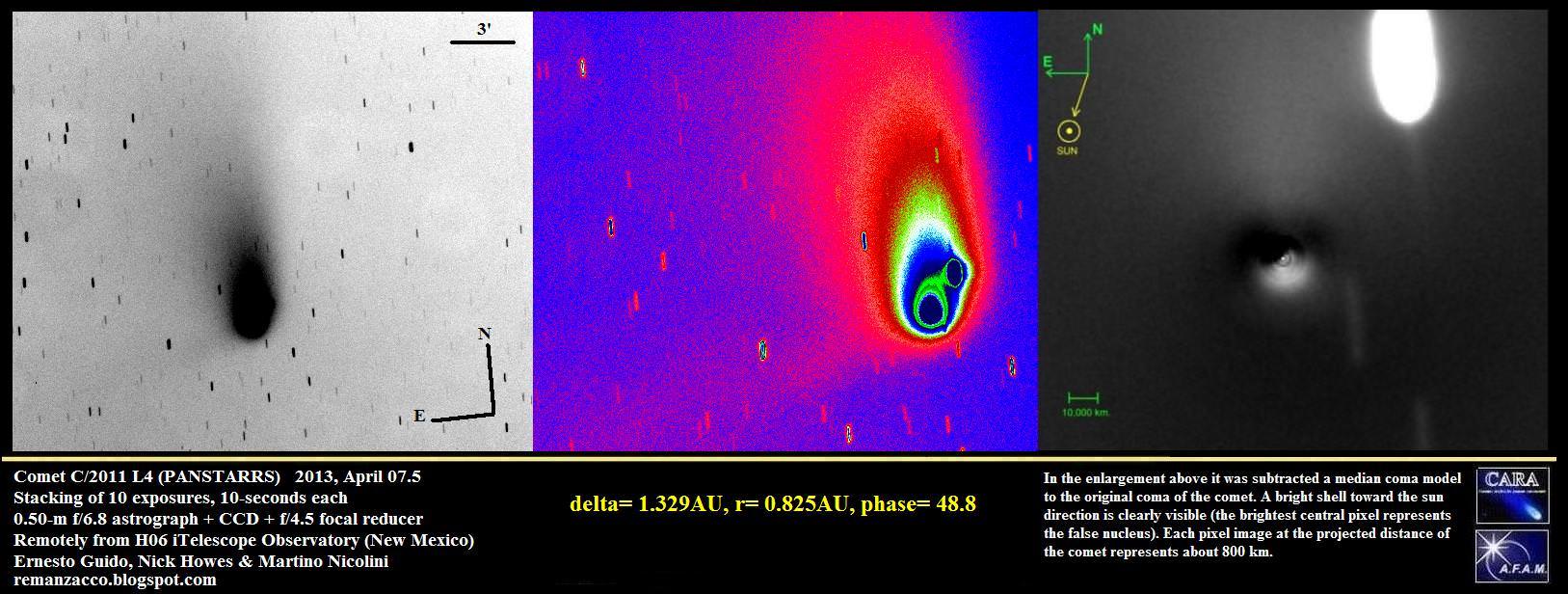
Comet PANSTARRS has peaked, but astronomers are still keeping an eye on this comet to try and determine what its future might hold. The team from the Remanzacco Observatory has just produced some really interesting views of Comet PANSTARRS, with a little help from Martino Nicolini and his Astroart software.
Team member Nick Howes called this software “one of the best astronomical image processing and acquisition tools around,” and explained how these views can tell astronomers more about what is happening with the comet.
“The isophotes image (color coded) is a good way to see the morphology/structure of the coma,” he told Universe Today, adding that comparing the images here is “a very good way to determine any major events like a fragmentation. We’re hopeful that once PANSTARRS gets a bit higher, we’ll be able to look at it in even more detail with the 2 meter Faulkes scopes.”
And with the image processing in the image on the far right, it’s possible to see a bright shell in the coma of comet C/2011 L4 (PANSTARRS).
“The last elaboration in that image has been obtained using the M.C.M. (Median Coma Model), a filter that has the purpose of creating — from an image of a comet — a synthetic model of the ‘regular’ coma,” said Ernesto Guido, from the Remanzacco team. “That is obtained by mapping all the pixels that compose the image and averaging them together. In doing so we delete all the morphological “non-uniformity” contained in the coma itself. This regular coma will then be subtracted from the original image highlighting all the details that are normally immersed in the uniform brightness of the coma.”
Check out the Remanzacco website for more information and their continued updates.
The Return of Saturn: A Guide to the 2013 Opposition
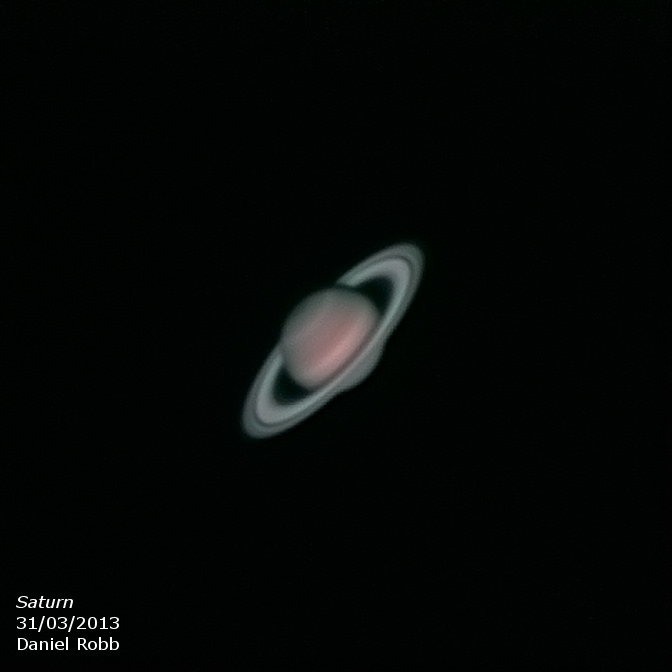
A star party favorite is about to return to evening skies.
The planet Saturn can now be spied low to the southeast for northern hemisphere observers (to the northeast for folks in the southern) rising about 1-2 hours after local sunset this early April. That gap will continue to close until Saturn is opposite to the Sun in the sky later this month and rises as the Sun sets.
Opposition occurs on April 28th at 8:00 UT/4:00AM EDT. Saturn will shine at magnitude +0.1 and appear 18.8” in diameter excluding the rings, which give it a total angular diameter of 43”.
Saturn has just passed into the faint constellation Libra for 2013, although its springtime retrograde loop will bring it back into Virgo briefly. Both the 2013 and 2014 opposition will occur in Libra. Saturn will also pass 26’ from +4.2 Kappa Virginis on July 3rd as it moves back into Virgo while in retrograde before resuming direct motion back into Libra.
Saturn currently lies about 15° to the lower left of the +1.04 magnitude star Spica, also known as Alpha Virginis. Remember the handy saying to “Spike to Spica” from the handle of the Big Dipper asterism to locate the region. Another handy finder tip; stars twinkle, planet generally don’t. That is, unless your skies are extremely turbulent!
With an orbital period 29.46 years, Saturn moves slowly eastward year to year, taking 2-3 years to cross through each constellation along the ecliptic.
Oppositions are roughly 378 days apart and thus move forward on our calendar by about two weeks a year. Successive oppositions also move about 13° eastward per year.
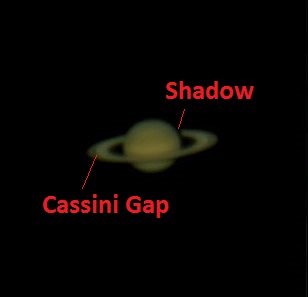
Oppositions of the ringed planet are also currently becoming successively favorable for southern observers over the coming years. Saturn crossed into the southern celestial hemisphere some years back, and will be at its southernmost in 2018.
Saturn won’t pass north of the celestial equator again until early 2026. Saturn is 15 million kilometres farther from us than opposition last year as its moving toward aphelion in 2018.
Saturn will reach eastern quadrature this summer on July 28th and stand its highest south at sunset northern hemisphere observers. South of the equator, it will pass directly overhead or transit to the north. Saturn will be with us for most of the remainder of 2013 in evening skies until reaching solar conjunction on November 6th.
Looking at Saturn with binoculars, you’ll immediately note that something is amiss.
You’re getting a view similar to that of Galileo, who sketched Saturn as a sort of “double handled cup.” In fact, it wasn’t until 1655 that Christian Huygens correctly hypothesized that the rings of Saturn are a flat disk that is not physically in contact with the planet.
Huygens also discovered the large moon Titan. Shining at magnitude +8.5 and taking 16 days to orbit Saturn, Titan is the second largest moon in our solar system after Ganymede. Titan would easily be a planet in its own right if it orbited the Sun. Titan is easily picked out observing Saturn at low power through a telescope.
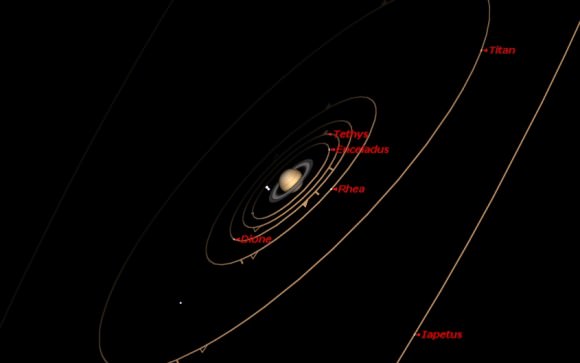
Observing Saturn at slightly higher magnification, five moons interior to Titan become apparent. From outside in, they are Rhea, Dione, Tethys, Enceladus, and Mimas. Exterior to Titan is the curious moon of Iapetus. Taking 79 days to complete one orbit of Saturn, Iapetus varies in brightness from magnitude +11.9 to +10.2, or a factor of over 5 times. Arthur C. Clarke placed the final monolith in the book adaptation of 2001: A Space Odyssey on Iapetus for this reason. Close-ups from the Cassini spacecraft reveal a two-faced world covered with a dark leading hemisphere and a bright trailing side, but alas, no alien artifacts.
But the centerpiece of observing Saturn through a telescope is its brilliant and complex system of rings. The A, B, and C rings are easily apparent through a backyard telescope, as is the large spacing known as the Cassini Gap.
The rings are also currently tilted in respect to our Earthly vantage point. The rings were edge-on in 2009 and vanish when this occurs every 15-16 years.
This year, we see the rings of Saturn at a respectable 19 ° opening and widening. The rings will appear at their widest at over 25° in 2017 and then become edge-on again in 2025.
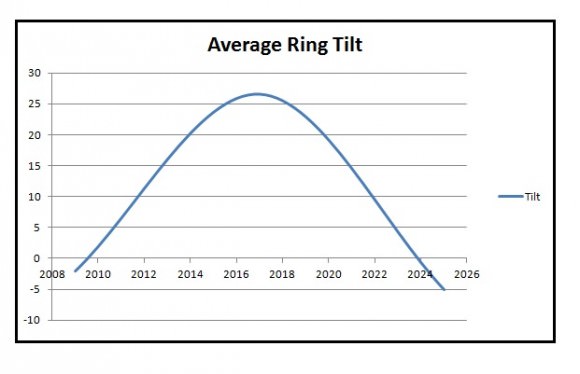
The ring system of Saturn adds 0.7 magnitudes of overall brightness to the planet at opposition this year.
Another interesting optical phenomenon to watch for in the days leading up to opposition is known as the “opposition surge” in brightness, or the Seeliger effect. This is a retro-reflector effect familiar to many as high-beam headlights strike a highway sign. Think of the millions of particles making up Saturn’s rings as tiny little “retro-reflectors” focusing sunlight back directly along our line of sight. The opposition surge has been noted for other planets, but it’s most striking for Saturn when its rings are at their widest.
The disk of Saturn will cast a shadow straight back onto the rings around opposition and thus vanish from our view. The shadow across the back of the rings will then become more prominent over subsequent months, reaching its maximum angle at quadrature this northern hemisphere summer and then beginning to slowly slide back behind the planet again. A true challenge is to glimpse the disk of the through the Cassini gap in the rings… you’ll need clear steady skies and high magnification for this one!
It’s also interesting to note a very shallow partial lunar eclipse occurs with Saturn nearby just three days prior to opposition on April 25th. Saturn will appear 4° north of the Moon and it may be just possible to image both in the same frame.
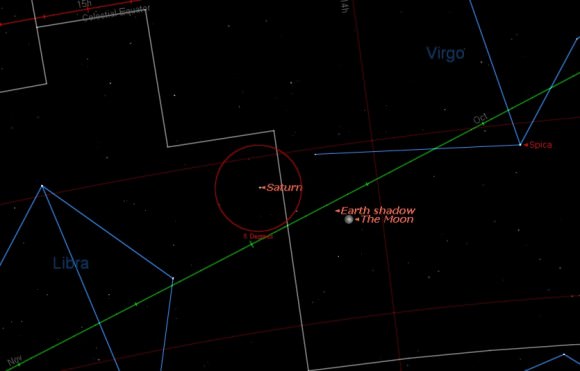
Saturn takes about 30 years to make its way around the zodiac. I remember just beginning to observe Saturn will my new 60mm Jason refractor as a teenager in 1983 as it crossed the constellation Virgo.Hey, I’ve been into astronomy for over one “Saturnian year” now… where will the next 30 years find us?

